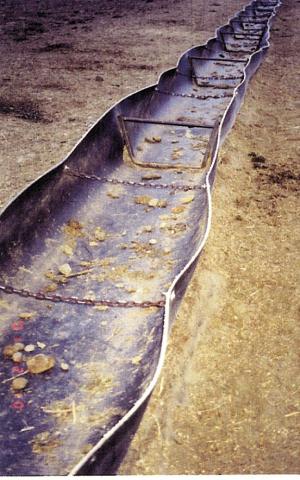Portable Feedbunks Made From Used Conveyor Belts
 ✖  |
When brothers Garry and Terry Smith, Leader, Saskatchewan, got a chance to buy more than 400 ft. of salvaged rubber conveyor belting from a mining company, they got the idea of hanging it inside pipe frames to make cattle feedbunks.
They built a frame and then spent hours trying to force a 30-ft. length of the 1/2-in. thick, 56-in. wide belting into it. After a while, they decided there had to be a better way.
They decided to use lengths of chain stretched from side to side to hold the sides up. They cut the belt into three equal lengths, about 133 ft. each.
To pull the edges up, they clamped a pair of welding C-clamp vice grips to each edge and then stretched a come-along between them. When they tightened up the come-along, the edges bent up just as they'd hoped, making 14-in. high sides.
To hold the sides together, they put bracing in the bunks about every four feet. Most of the bracing is 1/4-in. link chain, which they attached by drilling 3/8-in. holes through the belt, about 1 1/2-in. from the edges. The chain is cut in 28-in. lengths and fastened in the holes with 5/16-in. bolts. They used oversized washers on the outside of belt to keep the bolts from pulling through.
Every third brace, however, is made from channel iron, to provide extra stability. To make more sturdy braces, the Smiths cut 4-ft. lengths of 2 in. by 1-in. channel iron. They notched them 14 in. in from both ends, leaving 20 in. in the middle, and bent them up so the ends were 28 in. apart. Then they welded a 28-in. length of salvaged sucker rod to the ends. They bolted these to the belting by drilling a 5/16-in. hole through each side and one through the bottom.
They closed in the ends of the bunks by cutting flaps and folding them inward. The bunks can be pulled from one location to another with a tractor or pickup. "Getting them through gates can be a problem," Terry Smith says. "If you try to make too sharp a turn, they tend to roll. But they're not hard to turn back over. In the winter, they do freeze down, but you can pop them loose in two or three places by pushing them with the forks on an skidsteer or front end loader."
Smith says the feedbunks are so tough he figures they'll outlive him.
The brothers bought up more of the old belting when they found it available. If others would like to make feedbunks similar to theirs, contact Shur-Green Enterprises, Ltd.538 Sturgeon Drive, Saskatoon, Sask., Canada S7K 4E1 (ph 306 382-1944; fax 306 382-1053).

Click here to download page story appeared in.
Click here to read entire issue
Portable Feedbunks Made From Used Conveyor Belts LIVESTOCK Feeding Equipment 26-6-26 When brothers Garry and Terry Smith, Leader, Saskatchewan, got a chance to buy more than 400 ft. of salvaged rubber conveyor belting from a mining company, they got the idea of hanging it inside pipe frames to make cattle feedbunks.
They built a frame and then spent hours trying to force a 30-ft. length of the 1/2-in. thick, 56-in. wide belting into it. After a while, they decided there had to be a better way.
They decided to use lengths of chain stretched from side to side to hold the sides up. They cut the belt into three equal lengths, about 133 ft. each.
To pull the edges up, they clamped a pair of welding C-clamp vice grips to each edge and then stretched a come-along between them. When they tightened up the come-along, the edges bent up just as they'd hoped, making 14-in. high sides.
To hold the sides together, they put bracing in the bunks about every four feet. Most of the bracing is 1/4-in. link chain, which they attached by drilling 3/8-in. holes through the belt, about 1 1/2-in. from the edges. The chain is cut in 28-in. lengths and fastened in the holes with 5/16-in. bolts. They used oversized washers on the outside of belt to keep the bolts from pulling through.
Every third brace, however, is made from channel iron, to provide extra stability. To make more sturdy braces, the Smiths cut 4-ft. lengths of 2 in. by 1-in. channel iron. They notched them 14 in. in from both ends, leaving 20 in. in the middle, and bent them up so the ends were 28 in. apart. Then they welded a 28-in. length of salvaged sucker rod to the ends. They bolted these to the belting by drilling a 5/16-in. hole through each side and one through the bottom.
They closed in the ends of the bunks by cutting flaps and folding them inward. The bunks can be pulled from one location to another with a tractor or pickup. "Getting them through gates can be a problem," Terry Smith says. "If you try to make too sharp a turn, they tend to roll. But they're not hard to turn back over. In the winter, they do freeze down, but you can pop them loose in two or three places by pushing them with the forks on an skidsteer or front end loader."
Smith says the feedbunks are so tough he figures they'll outlive him.
The brothers bought up more of the old belting when they found it available. If others would like to make feedbunks similar to theirs, contact Shur-Green Enterprises, Ltd.538 Sturgeon Drive, Saskatoon, Sask., Canada S7K 4E1 (ph 306 382-1944; fax 306 382-1053).
To read the rest of this story, download this issue below or click
here to register with your account number.







